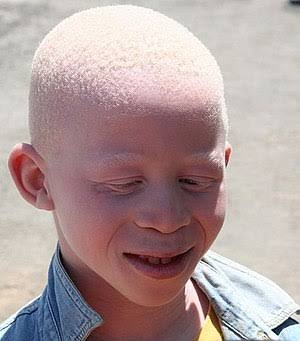Introduction
No man on the surface of the earth without his challenges. Some challenges are permanent while some are temporal. The permanent challenges are best taking care of under good counsellor/teacher. One of the permanent challenges that have no cure is albinism. This is inherited and it crosses across all ethnic groups in the world.

What is Albinism?
Albinism is an inherited genetic condition that reduces the amount of melanin pigment formed in the skin, hair and/or eyes. Albinism occurs in all racial and ethnic groups throughout the world. In the U.S., approximately one in 18,000 to 20,000 people has some type of albinism. In other parts of the world, the occurrence can be as high as one in 3,000. Most children with albinism are born to parents who have normal hair and eye colour for their ethnic backgrounds (National Organization for Albanism and Hypopigmentation, 2018).
A common myth is that people with albinism have red eyes. Although lighting conditions can allow the blood vessels at the back of the eye to be seen, which can cause the eyes to look reddish or violet, most people with albinism have blue eyes, and some have hazel or brown eyes. There are different types of albinism and the amount of pigment in the eyes varies; however, vision problems are associated with albinism (National Organization for Albanism and Hypopigmentation, 2018).
People with albinism often have lighter coloured skin and hair than the other members of their family or ethnic group. Vision problems are common. Melanin normally protects the skin from UV (ultraviolet) damage, so people with albinism are more sensitive to sun exposure. There is an increased risk of skin cancer (Newman, 2018).
Symptoms of Albinism
According to Newman (2018), the primary symptoms of albinism can affect the skin, hair, eye colour, and vision. The most obvious sign is a lighter skin tone, but skin tone does not always differ substantially. In some people, levels of melanin slowly increase over time, darkening skin tone as the person ages. The skin will likely burn easily in the sun. It does not usually tan. After exposure to the sun, some people with albinism might develop: freckles, moles, usually pink in colour due to the reduced quantities of pigment, lentigines, large freckle-like spots. There is also a higher risk of skin cancer. People with albinism should use sun protection cream of SPF 30 or higher and report any new moles or other skin changes to a doctor.
Newman (2018) further adds that hair in colour is another symptom. The hair is range from white to brown. Those of African or Asian descent tend to have yellow, brown, or reddish hair. As the individual ages, their hair color may slowly darken.
Eye colour is another symptom. This can also change with age and varies from very light blue to brown. Low levels of melanin in the iris mean that the eyes can appear slightly translucent and, in certain light, look red or pink as the light reflects off the retina at the back of the eye. The lack of pigment prevents the iris from fully blocking sunlight. This results in a sensitivity to light, known as photosensitivity (Newman, 2018).
One of the main symptoms is the vision. Newman (2018) submits that albinism always affects vision. Changes to eye function can include:
Nystagmus: The eyes move rapidly and uncontrollably back and forth.
Strabismus: The eyes do not function in unison.
Amblyopia: Also referred to as a “lazy eye.”
Myopia or hypermetropia: The person may have extreme nearsightedness or farsightedness.
Photophobia: The eyes are particularly sensitive to light.
Optic nerve hypoplasia: Visual impairment may result from an underdeveloped optic nerve.
Optic nerve misrouting: Nerve signals from the retina to the brain follow unusual nerve routes.
Astigmatism: An abnormal inflexibility of the front surface of the eye or lens results in blurred vision.

Teaching Strategies Suggested
Statewide Resource Centre explained that school management should ensure that all staff working with the students, including replacement teachers and volunteers, are aware of the vision impairment and its educational implications. The strategies are grouped into two; outdoor strategies and classroom strategies.
Outdoors
Dark or tinted glasses may be necessary to shield eyes from the light
sun hats can be useful both to shield the eyes from glare and the skin from the sun
students may be more comfortable wearing darker colours, especially on their upper body. Light coloured clothing may cause glare and discomfort especially when outside.
sun screen should be worn, even in the colder months; the student should carry sun screen and be encouraged to apply it as required
a pouch or shoulder bag may be required so that the student can carry their sun screen and other aids at all times
the teacher should keep the sun behind the student during teaching moments as bright light and glare will cause difficulties
larger balls with good contrast will assist
reading environmental signs e.g. street signs may cause difficulties
In the Classroom
Teachers should be very careful that the student with albinism is never seated facing into light and that the nystagmus (where present) is taken into account
control of light, or more particularly glare, is important in the classroom during school hours. If too much light enters the room, blinds or artwork can be placed over windows. If light cannot be conveniently controlled, a ‘dark corner’ set up for the student to go if s/he chooses may be beneficial. Remember though that eyes need a certain level of light to function. A large umbrella can offer shade over a student’s desk, as required. A beach or golf umbrella could form part of a classroom theme.
the use of shiny surfaces (e.g. white boards, shiny paper for worksheets, laminated flashcards, shiny table tops) should be avoided as they can reflect light toward the student’s eyes
reading material may need to be modified e.g. etext for novels, textbooks and handouts; text-to-speech and/or magnification. For young students it may be sufficient to bring reading material close to the eyes.
utilise high contrast materials e.g. black texta for writing, coloured textas for drawing, coloured paste, using clear bold illustrations to cut around
bold lined paper may assist
always use a clean white board with black marker. Use a consistent layout when presenting information on a board e.g. homework is always found on the far right hand side of the board.
a reading/writing stand can often assist, especially in primary school or for prolonged visual tasks. The use of a reading/writing stand will also help to occlude light from the eyes.
for writing sheets or exercise books, recycled paper (creamy or grey coloured) may be better than pure white paper, but remember that contrast is also important
optical or electronic magnification may assist with near work. If using an electronic magnifier, students with albinism may prefer to read white print on a black background.
paper colour, print size and type of magnification will need to be assessed on an individual basis
students will benefit from desktop demonstrations ensuring visual access e.g. correct handwriting formation of a new letter, science experiment etc
efficient organisational skills will assist a student with a vision impairment e.g. having a large pencil case to store pens, calculator and visual aids; setting aside extra time to collect any equipment required etc
additional verbal description and verification may be required to ensure the student has access to the learning environment e.g. describe a new classroom or excursion venue, provide verbal praise etc. The student with a vision impairment may miss a smile of encouragement!
the use of a laptop, iPad etc may be of great assistance to a student with a vision impairment as an alternative to handwriting and to reduce visual fatigue. Accessibility options, Software and apps are available for magnifying text and graphics, including icons, menus etc. Individual assessment of the needs of each student is essential. Keyboarding skills should be taught in primary school
strategies to reduce vision fatigue should be considered e.g. appropriate visual rests may include listening to audio tapes both for information and relaxation
students with a vision impairment often need to be taught social skills using a direct teaching approach. Modeling appropriate social behaviors can be difficult when you cannot see them accurately
students with a vision impairment may need additional orientation and mobility training
understanding and acceptance of the student’s vision impairment, individual learning modes and work production methods (e.g. braille, computer etc) may be facilitated through carefully planned simulation activities and class education programs
older students with albinism may benefit from genetic counseling. They may need advice on the likelihood of having children with albinism. This advice is available through the Royal Children’s Hospital which also conduct clinics at the Royal Women’s Hospital, Monash Medical Centre and in some country centres.
In a nutshell, Newman (2018) summarizes the strategies into four main points:
attaching special telescopic lenses attached to glasses
using a large computer screen or high-contrast print material
installing software that converts text to speech
using a brightly coloured ball when playing games
Causes of Albinism
A defect in one of several genes that produce or distribute melanin causes albinism. The defect may result in the absence of melanin production, or a reduced amount of melanin production. The defective gene passes down from both parents to the child and leads to albinism (healthline.com).
However, Newman (018) posits that albinism results from a mutation in one of several genes. One in 70 people are thought to carry the gene for albinism. The genes in question are responsible for various aspects of the production of melanin by melanocytes in the skin and eyes. Most commonly, the mutations interfere with the enzyme tyrosinase (tyrosine 3-monooxygenase). This enzyme synthesizes melanin from the amino acid tyrosine. Depending on the mutation, melanin production can either be slowed or completely stopped. Regardless of the amount of interference with melanin production, there are always problems with the visual system. This is because melanin plays a vital role in the development of the retina and the optic nerve pathways from the eye to the brain.
Types
Albinism is split into a number of subgroups depending on the specific genes that are affected. Newman (2018) states the following types of albinism:
Oculocutaneous albinism (OCA): This is caused by a mutation in 1 of 4 genes. OCA is further split into seven types depending on the mutations.
These subdivisions include:
OCA type 1: Individuals tend to have milky skin, white hair, and blue eyes. With age, some individuals’ skin and hair may darken.
OCA type 2: Less severe than type 1, this occurs most often in sub-Saharan Africans, African-Americans, and Native Americans.
OCA type 3: Vision problems are normally milder than in other types. This mostly affects black South Africans.
OCA type 4: This is most common among East Asian populations. It appears similar to type 2.
X-linked ocular albinism: This is caused by a gene mutation of the X chromosome. X-linked ocular albinism mainly affects males. Vision problems are present, but eye, hair, and skin color is generally in the normal range.
Hermansky-Pudlak syndrome: This rare variant is most common in Puerto Rico. The symptoms are similar to oculocutaneous albinism but bowel, heart, kidney, and lung diseases or bleeding disorders, such as hemophilia and more likely, too.
Chediak-Higashi syndrome: This is a rare form of albinism, caused by a mutation in the CHS1/LYST genes. Symptoms are similar to oculocutaneous albinism but hair can appear silvery, and the skin can look slightly gray. There may be defects in the white blood cells, making infections more common.
As research continues, more specific mutations may be discovered, helping us understand the underlying causes of albinism in more detail.
Inheritance: Most types of albinism are inherited in an autosomal recessive inheritance pattern. The exception is X-linked ocular albinism. This is passed on in an X-linked inheritance pattern.
Autosomal recessive inheritance: With autosomal recessive inheritance, an individual must receive faulty copies of a gene from the mother and father to develop albinism. The parent who carries the gene often does not show symptoms. If both parents carry the gene but have no symptoms, there is a 1 in 4 chance that their offspring will have albinism. There is a 1 in 2 chance that the offspring will become a carrier. They will have the gene but not have any symptoms. An estimated 1 in 70 people carry the genes associated with albinism but are not affected by the mutations.
X-linked inheritance: X-linked recessive conditions mainly affect males. Because females carry two X chromosomes, if one gene damaged, the other can often make up the shortfall. Females can still carry and pass on the gene. Men, however, have one X and one Y chromosome. This means that any albino mutations in their singular X chromosome will generate the condition. If the mother has an X-linked mutation, each daughter will have a 1 in 2 chance of becoming a carrier and each son will have a 1 in 2 chance of developing albinism.
Treatment of albinism
Because the disease is genetic, there are no cures. Treatment focuses on minimizing the symptoms and watching for changes. Getting the right care for eye problems is essential. Newman (2018) states the following treatments:
prescription glasses
dark glasses to protect the eyes from the sun
regular eye exams
People should watch for any skin changes and use sunblock for protection.
Surgery on the optical muscles can sometimes minimize the “shaking” in nystagmus.
Procedures to minimize strabismus can make it less noticeable, but surgery will not improve vision. The level of success in reducing symptoms varies between individuals.
Albinism does not worsen with age. A child with albinism can flourish and achieve the same education and employment as a person without the condition.
Complications
The most common physical problems associated with albinism are the increased risk of sunburnand skin cancers. Additionally, some people face significant social issues. These may include bullying at school. The person may be made to feel like an outsider because they look different. People with albinism in sub-Saharan Africa face the greatest challenges. These social factors can lead to stress, low self-esteem, and isolation. Individuals with albinism in sub-Saharan Africa face the most significant difficulties (Newman, 2018).
Conclusion
Albinism is an inherited genetic condition that reduces the amount of melanin pigment formed in the skin, hair and/or eyes. Albinism occurs in all racial and ethnic groups throughout the world. As a result it has no cure up till date. However teachers teaching children with this visual challenge should bear the disability in mind and make sure that they provide necessary care for them.
Recommendation
The following recommendation are hereby suggested for teachers taking care of students with albinism:
– make sure that they do not sit at the direction of sunlight
– make sure that they sit in front roll
– Do not allow other students to make jest of them
– guive them extra time when they are doing class exercise
References
Healthline (2019). Albinism. Sourced from https://www.healthline.com/health/albinism#risk-factors. Accessed on August 18 2019
National Organization for Albanism and Hypopigmentation, (2018). What is albinism?
Newman T. (2018). Everything you need to know about albinism. Sourced from https://www.medicalnewstoday.com/articles/245861.php. accessed on August 18 2019
Statewide Vision Resource Centr. Albinism. Sourced from http://svrc.vic.edu.au/about/vision-and-vision-impairment/albinism/. Accessed on August 18 2019




